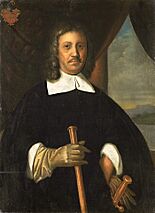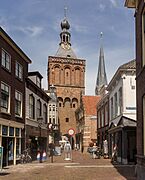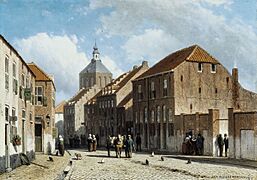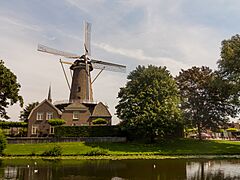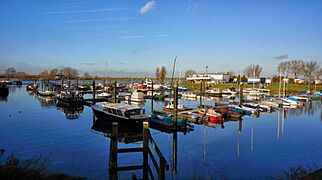Culemborg facts for kids
Quick facts for kids
Culemborg
|
|||
|---|---|---|---|
|
City and municipality
|
|||
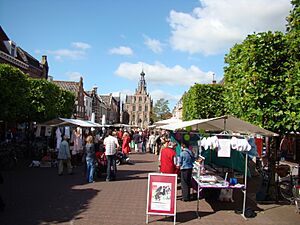
Culemborg market square
|
|||
|
|||

Location in Gelderland
|
|||
| Country | Netherlands | ||
| Province | Gelderland | ||
| Government | |||
| • Body | Municipal council | ||
| Area | |||
| • Total | 31.14 km2 (12.02 sq mi) | ||
| • Land | 29.42 km2 (11.36 sq mi) | ||
| • Water | 1.72 km2 (0.66 sq mi) | ||
| Elevation | 5 m (16 ft) | ||
| Population
(May 2014)
|
|||
| • Total | 27,568 | ||
| • Density | 937/km2 (2,430/sq mi) | ||
| Demonym(s) | Culemborger, Blauwlap | ||
| Time zone | UTC+1 (CET) | ||
| • Summer (DST) | UTC+2 (CEST) | ||
| Postcode |
4100–4107
|
||
| Area code | 0345 | ||
Culemborg is a city and municipality located in the center of the Netherlands. It is part of the Gelderland province. As of January 2022, about 29,386 people live there. The city is just south of the Lek river. You can easily travel by train from Culemborg's railway station. Direct trains go to Utrecht and Den Bosch. These trains cross the nearby railway bridge.
Contents
What's in a Name? The Story of Culemborg
The name Culemborg has changed over time. The oldest known spelling is Culenburgh from 1281. Other spellings like Kulenborch and Culemborch were used later. The first part of the name, Culen, means "hole" or "pit." The second part, borch, refers to a castle. This castle was built around 1270. So, the name likely means "castle by the pit."
A Look Back: Culemborg's History
Culemborg became a city in 1318, gaining special "city rights." For a long time, it was not officially part of the Netherlands. Instead, it was a small independent area called a "fiefdom" within the Holy Roman Empire. This fiefdom later became a "county."
The "Free City" of Culemborg
Culemborg was known as a "free city" (Vrijstad). This meant it had special rights. One right was to collect tolls, which are fees for using roads or bridges. Another important right was "asylum." This allowed people who had problems in other cities, like those who went bankrupt, to find safety in Culemborg. Their creditors (people they owed money to) could not enter the city to bother them. In Amsterdam, people would say "Going to Culemborg" if someone went bankrupt. But don't think criminals could escape justice! Culemborg had its own court system to deal with lawbreakers.
Culemborg's Walls and Waterways
A map from 1649 by Joan Blaeu shows Culemborg completely surrounded by walls. It also had canals that acted like a moat. The castle was actually outside these city walls. The houses in the city faced the streets, but behind them were gardens. Even inside the city walls, there were many market gardens where food was grown.
Changes and French Influence
In the early 1700s, Culemborg lost some of its independence. It became part of a larger Dutch region. Later, it was given to Willem IV, a Dutch leader. Even today, the current Dutch king, Willem-Alexander, holds the title of count of Culemborg. In 1795, French soldiers took over the city. They left the castle in such bad shape that it was torn down after they left. A few years later, Culemborg fully joined the Batavian Republic, losing its last independent rights.
Modern Times and Innovation
In 1868, a railway bridge was built over the Lek river near Culemborg. For a few years, it was the longest bridge in Europe! In 1995, Culemborg faced a risk of flooding. Many people had to leave their homes temporarily for safety. Between 1994 and 2009, Culemborg developed a special eco-friendly neighborhood called EVA Lanxmeer. People living there worked closely with designers to create a very sustainable area. This neighborhood is now famous worldwide for its smart, green design.
Getting Around: Transportation in Culemborg
Culemborg has its own train station. Trains run to Utrecht four times an hour. You can also catch trains to 's-Hertogenbosch and Tiel twice an hour. The station is also a hub for buses. Buses connect Culemborg to nearby towns and villages like Buren, Beusichem, and Nieuwegein. The railway bridge built in the 1860s was quite famous for its size at the time.
Local Businesses: Culemborg's Economy
Culemborg is home to some important companies.
- Rademaker BV: This company makes machines for processing dough. They moved to Culemborg in 1981 and still have their main office here.
- Centraal Boekhuis (now known as CB): This is the main company that distributes books in the Netherlands. They have been based in Culemborg since 1973.
Windmills of Culemborg
Culemborg has two traditional windmills that are still standing. They are called De Hoop and Johanna. The base of a third old mill, De Koornvriend, can also still be seen.
Famous Faces from Culemborg
Many notable people have connections to Culemborg:
- Anthony van Diemen (1593–1645): He was a Governor-General of the Dutch East Indies, a very important leader in what is now Indonesia.
- Jan van Riebeeck (1619–1677): He was a colonial administrator who helped found Cape Town in South Africa.
- Roelof de Man (1634–1663): He was a bookkeeper and worked closely with Jan van Riebeeck in Cape Town.
- Otto van Rees (1823–1892): He was a minister and also a Governor-General of the Dutch East Indies.
- Rudi Martinus van Dijk (1932–2003): A Dutch and Canadian composer who wrote music for orchestras, small groups, and singers.
- Wilhelmina Cooper (1939–1980): A famous fashion model who later started her own modeling agency, Wilhelmina Models, in New York.
- Farid Azarkan (born 1971): A politician and leader of the Denk political party.
- Jelka van Houten (born 1978): An actress.
Sport Stars
- Elly van Hulst (born 1959): A middle-distance runner who competed in the 1984 and 1988 Summer Olympics.
- Patrick Pothuizen (born 1972): A football (soccer) player who played in over 450 club matches.
- Michiel Elijzen (born 1982): A former professional road bicycle racer from the Netherlands.
Gallery
See also
 In Spanish: Culemborg para niños
In Spanish: Culemborg para niños





